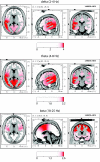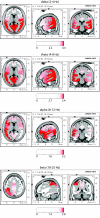Temporo-insular enhancement of EEG low and high frequencies in patients with chronic tinnitus. QEEG study of chronic tinnitus patients
- PMID: 20334674
- PMCID: PMC2858736
- DOI: 10.1186/1471-2202-11-40
Temporo-insular enhancement of EEG low and high frequencies in patients with chronic tinnitus. QEEG study of chronic tinnitus patients
Abstract
Background: The physiopathological mechanism underlying the tinnitus phenomenon is still the subject of an ongoing debate. Since oscillatory EEG activity is increasingly recognized as a fundamental hallmark of cortical integrative functions, this study investigates deviations from the norm of different resting EEG parameters in patients suffering from chronic tinnitus.
Results: Spectral parameters of resting EEG of male tinnitus patients (n = 8, mean age 54 years) were compared to those of age-matched healthy males (n = 15, mean age 58.8 years). On average, the patient group exhibited higher spectral power over the frequency range of 2-100 Hz. Using LORETA source analysis, the generators of delta, theta, alpha and beta power increases were localized dominantly to left auditory (Brodmann Areas (BA) 41,42, 22), temporo-parietal, insular posterior, cingulate anterior and parahippocampal cortical areas.
Conclusions: Tinnitus patients show a deviation from the norm of different resting EEG parameters, characterized by an overproduction of resting state delta, theta and beta brain activities, providing further support for the microphysiological and magnetoencephalographic evidence pointing to a thalamocortical dysrhythmic process at the source of tinnitus. These results also provide further confirmation that reciprocal involvements of both auditory and associative/paralimbic areas are essential in the generation of tinnitus.
Figures






Similar articles
-
High frequency localised "hot spots" in temporal lobes of patients with intractable tinnitus: a quantitative electroencephalographic (QEEG) study.Neurosci Lett. 2007 Oct 9;426(1):23-8. doi: 10.1016/j.neulet.2007.08.034. Epub 2007 Aug 22. Neurosci Lett. 2007. PMID: 17888572
-
Involvement of cortico-subcortical circuits in normoacousic chronic tinnitus: A source localization EEG study.Clin Neurophysiol. 2015 Dec;126(12):2356-65. doi: 10.1016/j.clinph.2015.01.027. Epub 2015 Feb 16. Clin Neurophysiol. 2015. PMID: 25753907
-
Targeting the parahippocampal area by auditory cortex stimulation in tinnitus.Brain Stimul. 2014 Sep-Oct;7(5):709-17. doi: 10.1016/j.brs.2014.04.004. Epub 2014 Apr 18. Brain Stimul. 2014. PMID: 25129400
-
Quantitative electroencephalography for tinnitus--a means for data collection, analysis, and translation.Int Tinnitus J. 2009;15(2):149-53. Int Tinnitus J. 2009. PMID: 20420339 Review.
-
Using resting state functional connectivity to unravel networks of tinnitus.Hear Res. 2014 Jan;307:153-62. doi: 10.1016/j.heares.2013.07.010. Epub 2013 Jul 26. Hear Res. 2014. PMID: 23895873 Review.
Cited by
-
Dysfunctional noise cancelling of the rostral anterior cingulate cortex in tinnitus patients.PLoS One. 2015 Apr 13;10(4):e0123538. doi: 10.1371/journal.pone.0123538. eCollection 2015. PLoS One. 2015. PMID: 25875099 Free PMC article.
-
Chronic pain as a brain imbalance between pain input and pain suppression.Brain Commun. 2021 Feb 16;3(1):fcab014. doi: 10.1093/braincomms/fcab014. eCollection 2021. Brain Commun. 2021. PMID: 33758824 Free PMC article.
-
Notched Sound Alleviates Tinnitus by Reorganization Emotional Center.Front Hum Neurosci. 2022 Jan 28;15:762492. doi: 10.3389/fnhum.2021.762492. eCollection 2021. Front Hum Neurosci. 2022. PMID: 35153700 Free PMC article.
-
MR-guided focused ultrasound technique in functional neurosurgery: targeting accuracy.J Ther Ultrasound. 2013 Apr 25;1:3. doi: 10.1186/2050-5736-1-3. eCollection 2013. J Ther Ultrasound. 2013. PMID: 24761224 Free PMC article.
-
Map plasticity following noise exposure in auditory cortex of rats: implications for disentangling neural correlates of tinnitus and hyperacusis.Front Neurosci. 2024 May 31;18:1385942. doi: 10.3389/fnins.2024.1385942. eCollection 2024. Front Neurosci. 2024. PMID: 38881748 Free PMC article.
References
-
- Hoffman H, Reed G. In: Epidemiology of tinnitus. Snow JB, editor. Lewiston, NY: B C Decker; 2004. Tinnitus: Theory and Management; pp. 16–41.
-
- Norena A, Micheyl C, Chery-Croze S, Collet L. Psychoacoustic characterization of the tinnitus spectrum: implications for the underlying mechanisms of tinnitus. Audiology & neuro-otology. 2002;7:358–369. - PubMed
Publication types
MeSH terms
LinkOut - more resources
Full Text Sources
Medical

